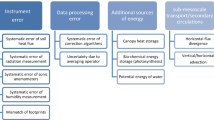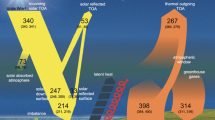Abstract
We present the results of numerical simulation of the action of hygroscopic particles on a convective cloud for obtaining additional precipitation. The correspondence of vertical profiles of cloud parameters to those actually observed under natural atmospheric conditions is achieved within a one-dimensional numerical model by parametrization of the process of heat and moisture entrainment into the upward air flow forming the cloud. The model describes in detail microphysical processes in a cloud with the use of the kinetic equation for the size distribution of cloud droplets. The processes of forming precipitation in convective clouds with a vertical thickness of 3–4 km during their natural development and during the introduction of hygroscopic particles are analyzed using numerical calculations. It is shown that it is actually possible to obtain additional precipitation from convective clouds of continental type under the action of hygroscopic particles with sizes of 1–1.5 μm. The results of calculating the intensity and total amount of precipitation as functions of the vertical thickness of a cloud and the parameters of particles introduced into it are presented. The conditions necessary for obtaining the maximum positive effect are elucidated.
Similar content being viewed by others
References
S. M. Shmeter and G. P. Beryulev, “Efficiency of Artificial Modification of Clouds and Precipitation with the Aid of Hygroscopic Aerosols,” Meteorol. Gidrol., No. 2, 43–60 (2005).
G. K. Mather, D. E. Terblanche, F. E. Steffens, and L. Fletcher, “Results of South African Cloud-Seeding Experiments Using Hygroscopic Flares,” J. Appl. Meteorol. 36, 1433–1447 (1997).
W. A. Cooper, R. T. Bruintjes, and G. K. Mather, “Some Calculations Pertaining to Hygroscopic Seeding with Flares,” J. Appl. Meteorol. 36, 1449–1469 (1997).
D. Caro, W. Wobrock, and A. I. Flossman, “A Numerical Study on the Impact Hygroscopic Seeding on the Development of Cloud Particle Spectra,” J. Appl. Meteorol. 41, 333–350 (2002).
Y. Segal, A. Khain, M. Pinsky, and D. Rosenfield, “Effect of Hygroscopic Seeding on Raindrop Formation As Seen from Simulation Using a 2000 Bin Spectral Cloud Parcel Model,” Atmos. Res. 71, 3–34 (2004).
A. S. Drofa, “Numerical Simulation of the Action on a Warm Convective Cloud by Hygroscopic Particles,” Izv. Akad. Nauk, Fiz. Atmos. Okeana 43, 623–635 (2007) [Izv., Atmos. Ocean. Phys. 43, 574–585 (2007)].
H. R. Pruppacher and J. D. Klett, Microphysics of Clouds and Precipitation (Oxford Univ. Press, Oxford, 1997).
L. T. Matveev, Course of General Meteorology: Atmospheric Physics (Gidrometeoizdat, Leningrad, 1984) [in Russian].
S. M. Shmeter, Thermodynamics and Physics of Convective Clouds (Gidrometeoizdat, Leningrad, 1987) [in Russian].
Yu. S. Sedunov, Physics of Forming the Liquid-Drop Phase in the Atmosphere (Gidrometeoizdat, Leningrad, 1972) [in Russian].
A. I. Flossman, W. D. Hall, and H. R. Pruppacher, “A Theoretical Study of the Wet Removal of Atmospheric Pollutants,” J. Atmos. Sci. 42, 583–606 (1985).
A. S. Drofa, “Formation of Cloud Microstructure During Hygroscopic Seeding,” Izv. Akad. Nauk, Fiz. Atmos. Okeana 42, 355–366 (2006) [Izv., Atmos. Ocean. Phys. 42, 326–336 (2007)].
V. M. Voloshchuk and Yu. S. Sedunov, Processes of Coagulation in Disperse Systems (Gidrometeoizdat, Leningrad, 1975) [in Russian].
R. S. Srivastava, “Size Distribution of Raindrops Generated by Breakup and Coalescence,” J. Atmos. Sci. 28, 410–415 (1971).
M. Komabayashi, T. Gonda, and K. Isono, “Lifetime of Water Drops before Breaking and Size Distribution of Fragment Droplets,” J. Meteorol. Soc. Jpn. 42, 330–340 (1964).
A. Kovets and B. Olund, “The Effect of Coalescence and Condensation on Rain Formation in a Cloud of Finite Vertical Extent,” J. Atmos. Sci. 26, 1060–1065 (1969).
H. T. Ochs and K. V. Beard, “Effect of Coalescence Efficiencies on the Formation of Precipitation,” J. Atmos. Sci. 42, 1451–1454 (1985).
T. L. Clark, “Numerical Modeling of the Dynamics and Microphysics of Warm Cumulus Convection,” J. Atmos. Sci. 30, 857–878 (1973).
Y. L. Kogan, “The Simulation of a Convective Cloud in a 3-D Model with Explicit Microphysics,” J. Atmos. Sci. 48, 1160–1189 (1991).
I. P. Mazin and S. M. Shmeter, Clouds: Structure and the Physics of Formation (Gidrometeoizdat, Leningrad, 1983) [in Russian].
F. Ya. Voit and I. P. Mazin, “Water Content of Cumulus Clouds,” Izv. Akad. Nauk SSSR, Fiz. Atmos. Okeana 8, 1166–1176 (1972).
Author information
Authors and Affiliations
Corresponding author
Additional information
Original Russian Text © A.S. Drofa, 2008, published in Izvestiya AN. Fizika Atmosfery i Okeana, 2008, Vol. 44, No. 4, pp. 435–449.
Rights and permissions
About this article
Cite this article
Drofa, A.S. Study of the possibility of stimulating precipitation from warm convective clouds by hygroscopic particles from numerical simulation. Izv. Atmos. Ocean. Phys. 44, 402–415 (2008). https://doi.org/10.1134/S0001433808040026
Received:
Accepted:
Published:
Issue Date:
DOI: https://doi.org/10.1134/S0001433808040026




